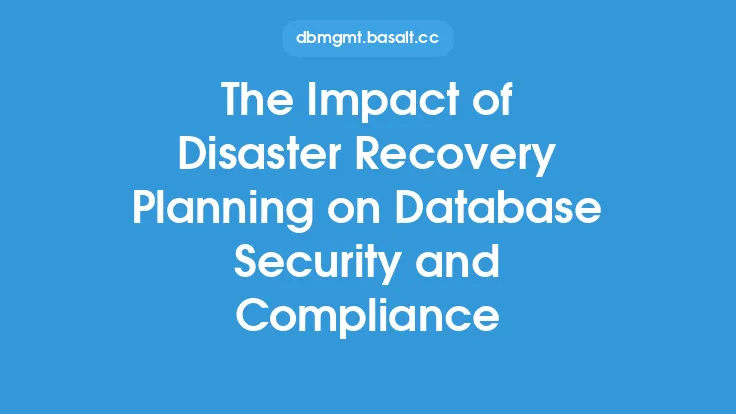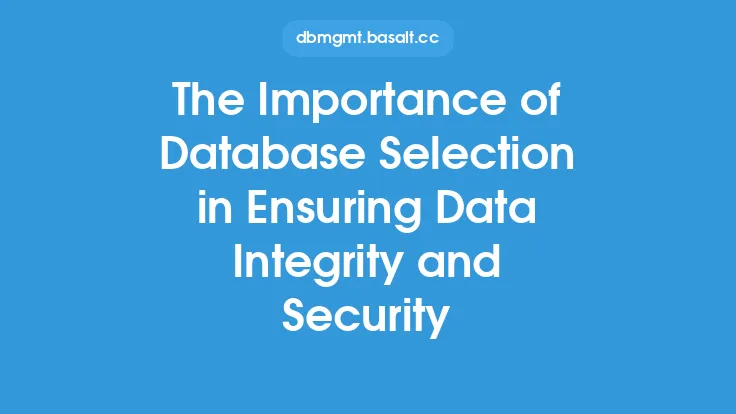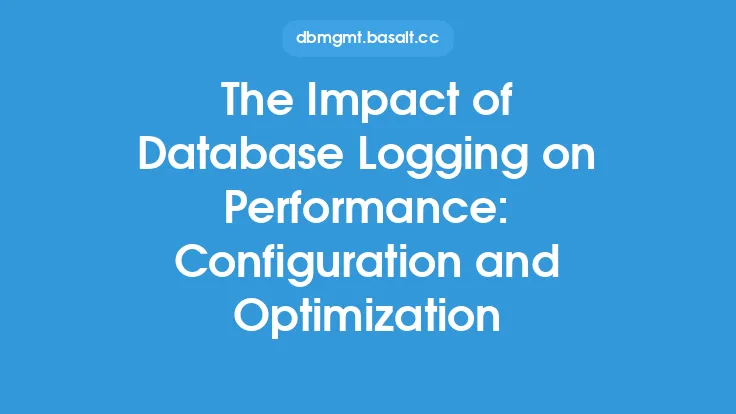Data archiving is a critical process in database management that involves storing data in a secure and compressed format for long-term retention. This process has a significant impact on data security and compliance, as it ensures that sensitive data is protected from unauthorized access and remains intact for future reference. In this article, we will delve into the impact of data archiving on data security and compliance, exploring the various methods and techniques used to ensure the integrity and confidentiality of archived data.
Introduction to Data Security and Compliance
Data security and compliance are two interconnected aspects of database management that are crucial for protecting sensitive data from unauthorized access, theft, or corruption. Data security refers to the measures taken to prevent unauthorized access, use, disclosure, disruption, modification, or destruction of data, while compliance refers to the adherence to regulatory requirements and industry standards for data management. Data archiving plays a vital role in ensuring data security and compliance by providing a secure and tamper-proof repository for storing sensitive data.
Data Archiving Methods and Their Impact on Security
There are several data archiving methods, including tape archiving, disk archiving, and cloud archiving, each with its own strengths and weaknesses. Tape archiving, for example, is a traditional method that involves storing data on magnetic tapes, which are then stored in a secure location. This method is highly secure, as tapes are difficult to access and modify, but it can be slow and cumbersome to retrieve data. Disk archiving, on the other hand, involves storing data on disk drives, which are faster and more accessible than tapes. However, disk archiving requires more maintenance and is more prone to data corruption. Cloud archiving, which involves storing data in a cloud-based repository, offers the benefits of scalability, flexibility, and cost-effectiveness, but it also raises concerns about data security and compliance.
Data Encryption and Access Control
Data encryption and access control are two critical components of data archiving that ensure the security and integrity of archived data. Data encryption involves converting data into an unreadable format using algorithms and keys, making it inaccessible to unauthorized users. Access control, on the other hand, involves restricting access to archived data to authorized personnel only, using techniques such as authentication, authorization, and auditing. By combining data encryption and access control, organizations can ensure that their archived data is protected from unauthorized access and remains compliant with regulatory requirements.
Compliance with Regulatory Requirements
Data archiving is subject to various regulatory requirements, including the General Data Protection Regulation (GDPR), the Health Insurance Portability and Accountability Act (HIPAA), and the Payment Card Industry Data Security Standard (PCI DSS). These regulations require organizations to ensure the confidentiality, integrity, and availability of sensitive data, including archived data. By implementing robust data archiving methods and techniques, organizations can demonstrate compliance with these regulations and avoid costly fines and penalties.
Data Integrity and Authenticity
Data integrity and authenticity are critical aspects of data archiving that ensure the accuracy and reliability of archived data. Data integrity involves ensuring that archived data is complete, accurate, and not modified or deleted, while data authenticity involves verifying the origin and ownership of archived data. By using techniques such as checksums, digital signatures, and audit trails, organizations can ensure the integrity and authenticity of their archived data, making it admissible as evidence in legal proceedings.
Best Practices for Data Archiving and Security
To ensure the security and compliance of archived data, organizations should follow best practices for data archiving, including:
- Developing a comprehensive data archiving policy that outlines procedures for data retention, storage, and disposal
- Implementing robust access controls, including authentication, authorization, and auditing
- Using data encryption and compression to protect archived data
- Regularly testing and verifying the integrity and authenticity of archived data
- Ensuring compliance with regulatory requirements and industry standards
- Providing training and awareness programs for personnel involved in data archiving and management
Conclusion
In conclusion, data archiving has a significant impact on data security and compliance, as it ensures the confidentiality, integrity, and availability of sensitive data. By implementing robust data archiving methods and techniques, organizations can protect their archived data from unauthorized access, ensure compliance with regulatory requirements, and demonstrate due diligence in the event of a data breach or legal proceeding. As data archiving continues to evolve, it is essential for organizations to stay informed about the latest methods and techniques for ensuring the security and compliance of their archived data.





